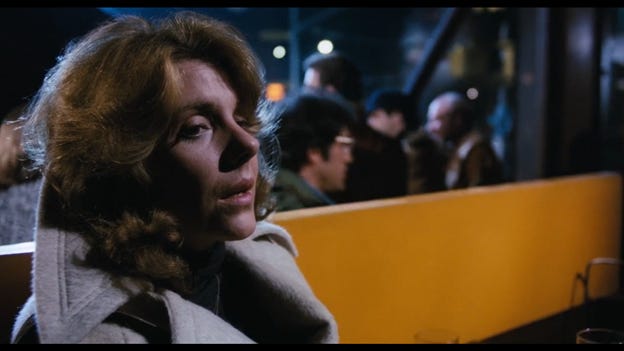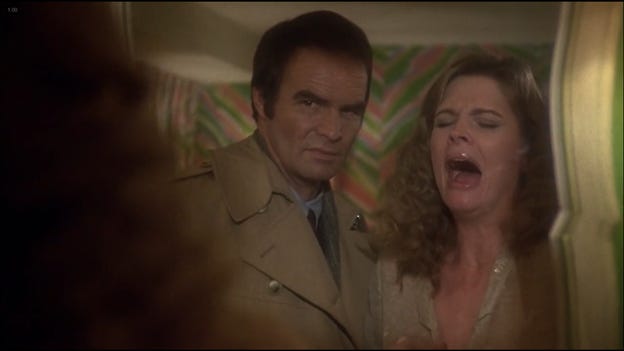(For installment one of the Age of Deuterogamy go here.)
An Unmarried Woman (1978)
Paul Mazursky’s An Unmarried Woman is a collection of observations about divorce by a great filmmaker who, it should be noted, was married to one woman from 1953 until his death in 2014. “I never thought of myself as a maven about marriage, about divorce, about anything,” he told interviewer Sam Wasson. “Don’t forget, I was never divorced, but I had been around a lot of divorced people.”
Jill Clayburgh plays an affluent New Yorker who works in an art gallery and is happy in her marriage to a good provider (Michael Murphy). After lunch at a period Soho landmark, Murphy tells her he’s fallen in love with someone else and is leaving her. She throws up.
In the days and months that follow we witness her anger; her shifting interactions with her ex-husband; her first post-marital lay. The look on Clayburgh’s face when she decides that she will sleep with the first man since her husband is a bitter flower blooming, and hearkens back to Norma Shearer in The Divorcee.
Lisa Lucas is very good as the teenaged daughter, angry at dad and loyal (up to a point) to mom. Totem-faced, real-life therapist Penelope Rusianoff plays Clayburgh’s therapist. Mazursky gives himself a cameo as a Jewish movie wheeler-dealer named Hal (same as in his Alex in Wonderland) who, anticipating Rambo, is producing a “new picture about an ex-Viet Nam vet who comes back to a small midwestern town and shoots three hundred people.”
Mazursky wanted to avoid ending with a happy new relationship. Clayburgh therefore at least postpones any elopement with her post-divorce love interest. Alan Bates has never been persuasive to me in the role, though. Perhaps their romantic inertness is why the ending of the movie feels less successful than it should, even as an open-ended farewell to Clayburgh’s character in her singledom. The movie is nevertheless a landmark of the Age of Deuterogamy—and a love letter to New York City in the late 1970s.
Clayburgh said in an interview that she was surprised that some viewed her character through a feminist lens. “To me,” she said, “it just seemed like this wonderful little movie that had a lot of say about humanity, not feminism.” This is absolutely right. There is much for both women and men to identify with in Clayburgh’s performance and the movie as a whole, and Mazursky doesn’t grind the usual ideological axes though he is interested in what has happened to the culture.
At one point in the movie, Clayburgh’s women friends complain about the lack of models of femininity with spine, class, zest. One asks: “Where are all the wonderful women that were in the movies in the old days? Bette Davis? Katherine Hepburn? Joan Crawford? Where are the women?”
We might ask ourselves the same question today—a question that second-wave feminism posed but answered poorly. In response to “Where are the women?” another friend feebly suggests Jane Fonda and Barbra Streisand.
Starting Over (1979)
For my money, Alan Pakula’s Starting Over is the best divorce movie of this late 1970s – early 1980s wave that announces the Age of Deuterogamy. Burt Reynolds, revealed sans moustache in the somber brown light of cinematographer Sven Nykvist, is stellar as a sad and shell-shocked divorced man. Aptly titled, the movie gives us the life mechanics of the newly regressed bachelor in his bare-bulb apartment, sleeping in a sleeping bag on the floor, assembling basic home furnishings in a shuttle of shopping carts. He turns on the radio to bring some music to the place and gets a cover of “The Way We Were” before shutting it off.
Yet the movie is a comedy, finding appeal in the awkward struggles and small graces of post-married existence. James L. Brooks wrote the script. Reynolds’s character has no children, which admittedly makes the movie less profound and its story easier to tell than that of its rivals, but it works.
Reynolds in Starting Over is no ladies’ man. His brother (Charles Durning) attempts to set him up with a shy kindergarten teacher played by Jill Clayburgh, and the two of them share a bruised bewilderment, a nervousness, a painful need to find trustworthy companionship and then exhale. The film captures what it is like to go on the first date in a decade. Later in the film, Reynolds has an anxiety attack while furniture shopping.
Candice Bergen as Reynolds’s narcissistic ex, pursuing a successful career as a Me-Decade songwriter, delivers one of the best comic scenes in all of film when she serenades Burt with her latest radio hit. “Bettah than evah,” she croons, blouse unbuttoned, enraptured with the sight of herself in the mirror. Reynolds, her prop, looks on incredulously: “Have you lost your marbles?”
Like Kramer vs. Kramer, Starting Over shares an Age of Deuterogamy rejection of the ‘70s cult of self-exploration. Reynolds cuts his ties with the Grammy-bound Bergen in favor of the kindergarten teacher who wants to have babies.
It’s My Turn (1980)
Clayburgh was nominated for best actress in consecutive years for her performances in An Unmarried Woman and Starting Over. These make an Age of Deuterogamy trilogy with It’s My Turn. Here, Clayburgh plays a mathematics professor drifting along in a relationship with an affable but emotionally shallow Charles Grodin. On the occasion of her widowed father’s remarriage, she becomes romantically involved with her stepbrother-to-be, a bearded Michael Douglas as a former major league baseball player.
It’s My Turn is not a divorce movie, but it is very much a film of marriage and remarriage. Grodin’s character is divorced with kids from his previous marriage. Douglas’s is married, and a father, and is working through a marital crisis after discovering his wife was unfaithful.
And it’s a good movie. The script, by Eleanor Bergstein (who wrote the Dirty Dancing screenplay), is intelligent and quirky, with a subtle 1930s screwball vibe. (It brings out in Clayburgh a touch of Jean Arthur.) The director, Claudia Weill, had two years earlier directed the excellent art house movie Girlfriends. The cinematographer is Bill Butler (The Conversation, Jaws).
The result should have been the masterpiece that is everywhere partly visible through the veil of the latter-day Hollywood rom-com that shrouds it. Weill later spoke resentfully of battles she lost with producer Ray Stark, so I am inclined to suspect that he was the culprit, though it is hard to tell if the movie ought to have been more polished and commercial or more idiosyncratic and awkward. In any case, it deserves far more attention than it has received.
The movie may suffer precisely from its strengths in Clayburgh and Douglas. They do everything very well but each of these two half-Jews is just a bit too attractive and unweathered for the role. Nevertheless, their interactions are enjoyably quick and off-kilter, as when Douglas looks over at Clayburgh in her late-70s, early-80s scarves and fabrics:
“Why are your clothes so dumb?”
“You’re dumb.”
“I’m a ball player.”
There is a scene with Clayburgh and Grodin in which she helps him edit a housing development pitch he’s writing—an extraordinary thing, to have a scene in which two characters work over a piece of professional writing. (They don’t quite bring out the throughline of the scene: Clayburgh’s realization that their relationship has tipped over its half-life.)
But the movie needs just a little more vérité, a little more Asperger’s. Clayburgh seems comfortable in her body in exactly the way that math professors aren’t,[1] and while she’s good at editing ad copy, her mind seems entirely unburdened of differential equations.
Yet the years have added to the movie, which shows more of its screwball graces with the distancing effect of its emerging period feel. For their wedding, Clayburgh buys her father and his wife a Cuisinart.
Next post: Rich Kids and Too Far To Go
[1] Literature professors, too.









